
News
Behind the Headlines
Two-Cents Worth
Video of the Week
News Blurbs
Articles
Testimony
Bible Questions
Internet Articles (2015)
Internet Articles (2014)
Internet
Articles (2013)
Internet Articles (2012)
Internet Articles (2011)
Internet Articles (2010)
Internet Articles
(2009)
Internet Articles (2008)
Internet Articles (2007)
Internet Articles (2006)
Internet Articles (2005)
Internet Articles (2004)
Internet Articles (2003)
Internet Articles (2002)
Internet Articles (2001)

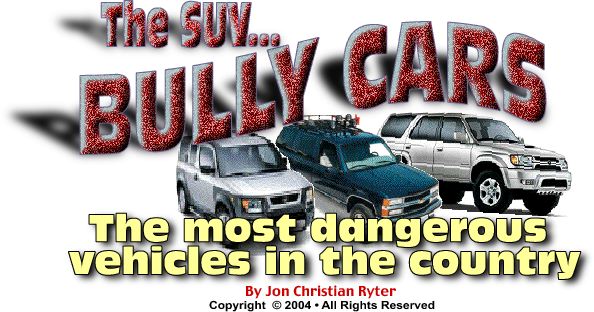
 f
you're an anti-gas guzzling environmentalist who receives an annual grant
from the Rockefeller or Pew Foundations, or the Carnegie Trust, or you're
a member of Sierra Club or the Nature Conservatory, or if you're on the
Board of Standard Oil, Exxon-Mobil, Atlantic Richfield, Sunoco, Conoco-Phillips,
BP-Amoco, Chevron-Texaco, Shell, Gulf, Sohio, or Sinclair, you'll love
this article. That is, you will until you remember that I'm one of those
rightwingers who knows global warming is myth created by the same foundations
and petroleum giants who quietly fund the advocacy of the ecoalarmist
idiots who believe the sky is falling. But, conversely, I also know that
increased gas and fuel oil consumption and the price of crude oil at the
wellhead is used to compute inflation in the United States—and both
consumption and inflation are rising. And both will eventually take money
from my pocket in the form of higher prices and higher taxes.
f
you're an anti-gas guzzling environmentalist who receives an annual grant
from the Rockefeller or Pew Foundations, or the Carnegie Trust, or you're
a member of Sierra Club or the Nature Conservatory, or if you're on the
Board of Standard Oil, Exxon-Mobil, Atlantic Richfield, Sunoco, Conoco-Phillips,
BP-Amoco, Chevron-Texaco, Shell, Gulf, Sohio, or Sinclair, you'll love
this article. That is, you will until you remember that I'm one of those
rightwingers who knows global warming is myth created by the same foundations
and petroleum giants who quietly fund the advocacy of the ecoalarmist
idiots who believe the sky is falling. But, conversely, I also know that
increased gas and fuel oil consumption and the price of crude oil at the
wellhead is used to compute inflation in the United States—and both
consumption and inflation are rising. And both will eventually take money
from my pocket in the form of higher prices and higher taxes.
The United States is currently importing roughly 11.3 million barrels of crude oil from other nations each week. That's roughly 48.59 million barrels a month. In addition, we also import 1.3 million barrels of refined gasoline per week, or 5.59 million barrels per month. Assume for a moment that all of it was being fed into our gas tanks (which, of course, it isn't. Some is refined into fuel oil and some into jet fuel.) Combined, that's a total of 54.18 million barrels of petroleum that American refineries processed for consumption by American drivers on American highways. Measured in terms of real money, the oil refineries are spending $500 million per day. At roughly $1.95 per gallon for gasoline at the pump, the American consumer is footing the bill—at about $6 trillion per month. (Hefty profit for the oil companies, isn't it?) Gasoline consumption is rising dramatically in the United States because American auto makers are producing much heavier, much less energy efficient vehicles that consume two to three times the amount of fuel than the lighter, more efficient vehicles that were produced only a decade earlier.
Walk onto a new car dealer's lot or showroom floor anywhere in the country and you will discover very few cars for sale. At least, they have very few cars on display in the showroom—and very few cars sitting on their lots. You will, however, find row after row of SUVs, mini-vans and monster pickup trucks. My wife and I just purchased two vehicles within the past month and shopped new car Ford and Chrysler dealerships in a five State area. While we saw a few new cars on each lot, 80% to 90% of the inventories at every dealership were bully cars—big, ugly road hogs. Monster trucks up in the new Ford F350 size, and gas guzzling SUVs coming out the wahzoo.
We are witnessing a dangerous
trend in America that must be reversed quickly or the death-toll on America's
highways is going to escalate. For
the rapidly growing number of Americans out there, both male or female,
who own a bully vehicle— either a SUV or a monster truck—be
thankful that I'm not the governor of your State because if I was, you'd
be paying a hefty $1,000 per year license tag fee for the pleasure of
driving your bully road hog—especially if you're driving a modified
monster truck. The tag tax wouldn't have anything to do with the fact
that bully vehicles are gas hogs, or because some liberal eco-alarmist
thinks they spew too much carbon dioxide into the atmosphere. The last
time I looked, carbon dioxide was the food a fertile Earth needs to grow
grass and produce oxygen. That's another argument for another day. This
one by itself, I suspect, isn't gong to win me any new friends because
tiny petite liberal .jpg) soccer moms love their their bully cars as much as the Reagan Democrats
or NRA Republicans love their monster trucks with the gun racks in the
back window. Quite simply, the tag tax would be a luxury tax assessed
against spoiled consumers who believe they should be allowed to have whatever
they want simply because they can afford it.
soccer moms love their their bully cars as much as the Reagan Democrats
or NRA Republicans love their monster trucks with the gun racks in the
back window. Quite simply, the tag tax would be a luxury tax assessed
against spoiled consumers who believe they should be allowed to have whatever
they want simply because they can afford it.
SUVs—the oversized road
hogs of suburban America—have become so popular that there are now
almost 25 million of them on the nation's roads, and they are growing
at a phenomenal rate. It is hard to tell how many oversized recreational
pickup trucks and monster trucks are on the road, since many of the trucks
are modified after they are purchased from a dealer. SUVs, without even
considering recreational pickup trucks or monster trucks account for 5.3%
of the vehicles on the nation's highways—and 14.1% of the accidents.
The most common accident suffered by the SUV are, of course, rollovers
that happen because of the high center of gravity in the SUV. My dislike
for bully cars is based on that faulty design, but not because of their
propensity to roll over..jpg) My dislike for bully cars of any type is based on the fact that just having
them on the road creates a hazard for the occupants of standard vehicles
who have the misfortune of sharing the highways with them. Included in
that group, of
My dislike for bully cars of any type is based on the fact that just having
them on the road creates a hazard for the occupants of standard vehicles
who have the misfortune of sharing the highways with them. Included in
that group, of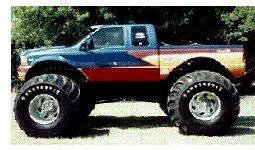 course, are monster pickup trucks and other vehicles that have been modified—
either by the dealer or in the owner's garage with conversion kits—in
order to compete with the other road hogs and bully vehicles for "presence"
on America's increasingly crowded highways and byways.
course, are monster pickup trucks and other vehicles that have been modified—
either by the dealer or in the owner's garage with conversion kits—in
order to compete with the other road hogs and bully vehicles for "presence"
on America's increasingly crowded highways and byways.
Let's start with the obvious.
Due to their high center of gravity, SUVs are simply not safe. In the
year 1998, when the SUV rollover problem became the focus of a national
study, statistics revealed that 29,000 Americans died in all vehicular
accidents that year. Out of approximately 130 million cars on the road,
there was a nationwide auto fatality rate of 22 people per 100 thousand
vehicles. Out of the 16 million SUVs on the road, there were 4.5 thousand
traffic fatalities—a rate of 28 people per thousand—or a 27%
increase over the national average. Interestingly, a study performed by The Center For Transportation Injury Research, published in The
Journal of Trauma Injury, Infection & Critical Care noted that,
generally speaking, as motor vehicles become lighter to achieve fuel efficiency,
fatalities and serious injuries increase in direct proportion. Nevertheless,
there was still a marked increase in the  percentage
of fatalities in drivers and passengers of SUVs even though they are considerably
heavier than most passenger vehicles on the roadways of America.
percentage
of fatalities in drivers and passengers of SUVs even though they are considerably
heavier than most passenger vehicles on the roadways of America.
The study further noted in 798 collisions (in which a fatalities resulted while the occupants of the vehicles were wearing seat belts) between SUVs and traditional vehicles, 76% of the fatalities were the drivers or passengers of the traditional cars. The risk to the occupants of the traditional vehicle involved in an accident with a bully car is 24 times greater than it is to the occupants of the SUV and monster truck. Earlier statistics on vehicular fatalities in which the accidents were head-on collisions between a traditional car and an SUV showed that, overwhelmingly, the fatalities occurred in the cars, not the SUVs. What makes these statistics more chilling is that it is now estimated that 34% of all of the vehicles on the road today are bully vehicles of some sort—either SUVs, heavy duty recreational pickup trucks, or modified monster trucks that are designed for street use. Even in 57 fatal crashes where the cars involved outweighed the SUV by an average of 234 lbs., the occupants of the cars still faced a 1.7 times greater risk of death. By 2008, if the current rate of sales continues, 50% of the cars on the road will be bully cars whose drivers are generally more aggressive than the drivers of standard vehicles.
By 2000 questions of the safety
of the Ford Explorer were being debated on the front pages of America's
newspapers.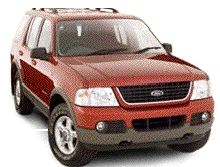 More than 200 deaths and well over 700 serious injuries were blamed on
the faulty high center of gravity of the SUV. Ford, on the other hand,
blamed its primary tire vendor, Firestone. The legal eagles found Bridgestone's Canton, Ohio tire
subsidiary much easier target than Ford Motor Company, and swooped
in for the kill. Before you could say "Harvey Firestone" ten
times, Lieff Cabraser Heimann & Bernstein, LLP filed suit not
only against Firestone and its Japanese parent, Bridgestone,
it also sued Ford Motor Company, because, they claimed in their
suit, "...[the Explorer's] unreasonable tendency to roll over...Ford
recommended that tires used on the Explorer be
More than 200 deaths and well over 700 serious injuries were blamed on
the faulty high center of gravity of the SUV. Ford, on the other hand,
blamed its primary tire vendor, Firestone. The legal eagles found Bridgestone's Canton, Ohio tire
subsidiary much easier target than Ford Motor Company, and swooped
in for the kill. Before you could say "Harvey Firestone" ten
times, Lieff Cabraser Heimann & Bernstein, LLP filed suit not
only against Firestone and its Japanese parent, Bridgestone,
it also sued Ford Motor Company, because, they claimed in their
suit, "...[the Explorer's] unreasonable tendency to roll over...Ford
recommended that tires used on the Explorer be 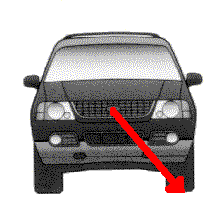 underinflated,
which had the consequence of increasing the likelihood of tire separation.
The "tilt" that occurs when the SUV leans into the turn places
too much pressure on the sidewalls of the tire, causing a blowout that
can, and in many cases, did cause the rollover to occur. In addition to
the primary action filed in federal court against both Firestone and Ford Motor Company, Ford was named as the defendant in scores
of other lawsuits involving the Explorer. Ford Motor Company settled
some of those actions without going to court and litigated those it felt
it could win. Ford declined to say how many cases were settled, or how
much money it paid out to plaintiffs in those actions.
underinflated,
which had the consequence of increasing the likelihood of tire separation.
The "tilt" that occurs when the SUV leans into the turn places
too much pressure on the sidewalls of the tire, causing a blowout that
can, and in many cases, did cause the rollover to occur. In addition to
the primary action filed in federal court against both Firestone and Ford Motor Company, Ford was named as the defendant in scores
of other lawsuits involving the Explorer. Ford Motor Company settled
some of those actions without going to court and litigated those it felt
it could win. Ford declined to say how many cases were settled, or how
much money it paid out to plaintiffs in those actions.
In a June 16, 1989 internal
memo to Ford management, Ford Motor Company engineers recommended
eight major design changes to address the rollover problem of the Ford
Explorer. The modifications would improve the safety of the vehicle. The
recommended changes would have taken ten months to implement and would
have delayed the  planned
launch of the Explorer. Management authorized only those changes that
could be made without affecting the production date of the Explorer. According
to Lieff Cabraser Heimann & Bernstein, LLP, who used the internal
memo in their lawsuit against Ford Motor Company, the changes that
were not made were those that would have corrected the stability and handling
problems identified during the development of the Ford Explorer.
planned
launch of the Explorer. Management authorized only those changes that
could be made without affecting the production date of the Explorer. According
to Lieff Cabraser Heimann & Bernstein, LLP, who used the internal
memo in their lawsuit against Ford Motor Company, the changes that
were not made were those that would have corrected the stability and handling
problems identified during the development of the Ford Explorer.
The National Highway Transportation Safety Administration noted that the rate of serious injury in passenger vehicles that experience a rollover is 36% higher than in crashes were there was no rollover. In addition, more than 90% of the passenger vehicle rollover crashes are single-vehicle accidents. In 2003, 8,345 of the 10, 142 people who died in car accidents in the United States died in single vehicle rollovers.
But as dangerous as SUVs are
for the occupants of those vehicles driving at high speeds on the highway,
they pose an even greater hazard to the cars that share the roadways with
them. And that's the reason I 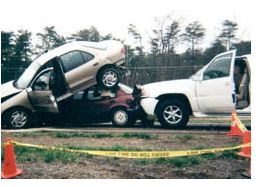 advocate
levying a $1,000 annual user fee on the owner of all bully cars regardless
if they are SUVs, monster trucks or modified trucks.
advocate
levying a $1,000 annual user fee on the owner of all bully cars regardless
if they are SUVs, monster trucks or modified trucks.
Most people who drive bully cars, drive them because they feel they are the masters of the road when they are behind the wheel. However, if you ask them "on the record," I'm certain that most people who drive them would say they do so because they feel much safer in a monster vehicle than, say, they would be in a Chevy Cavalier, Pontiac Sunbird, Plymouth Neon or Honda Civic. In a two-car collision in which no rollover occurs, the odds are 3 to 1 that the driver and passengers of the bully car will walk away from the accident with only minor, if any, injuries. And that's the primary reason most people buy them. But it is the size and displacement of the bully vehicles that make them a hazard to everything else on the highway—except, of course, something bigger—like a Peterbilt tractor-trailer.
Bully cars are simply too tall. The high center of gravity that creates the rollover characteristics which make SUVs dangerous for the occupants also creates "blind zones" that make SUVs even more dangerous to traditional vehicles with low centers of gravity that share the roads with them, making accidents caused by those blind zones more likely.

Road-conscious, defensive drivers
avoid accidents by remaining alert to what is happening in front of the
vehicle just ahead of them, and also what is going on with the vehicles
behind them. As drivers, we do that by looking around those vehicles
as the road bends and dips. But we also look through the windshield
of the car in from of us to gauge the speed of the vehicles in front of
that car (another justification for banning windshield tinting on the
rear window of any vehicle). If a car in front of the vehicle just ahead
of us slams his brakes to avoid hitting a squirrel running across the
road, our reaction time is at least equal to that of the driver immediately
in front of us, and a rear-end collision is avoided. If the center
of gravity of his vehicle is higher than ours, then the rear window of
the vehicle in front of us will also be higher than the visual area in
our windshield and we will not be able to "look" through his
windshield at the road in front of him. If the driver in the vehicle
in front of us is daydreaming when the car in front of him slams on his
brakes, and he's driving a vehicle with a high center of gravity, then 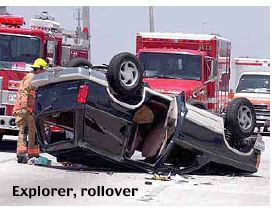 the
line of sight blind zone will prevent us from seeing the brake lights
in front of him, and we will not react until his brake lights warn us—which
may very well be when he piles into the car in front of him.
the
line of sight blind zone will prevent us from seeing the brake lights
in front of him, and we will not react until his brake lights warn us—which
may very well be when he piles into the car in front of him.
That line of sight blind zone will cause a delay in reaction time since we have to wait for the driver just ahead of us to react to what is happening on the road in front of him before we can react to him. If the emergency is two or three vehicles ahead of the vehicle in front of us, the reaction time of every driver is diminished by a few seconds, and the odds of a multiple car rear-ender is greatly increased—particularly if those vehicles are traveling at "highway speed" when the incident occurs. If you have ever wondered how chain-reaction rear-enders happen, this scenario provides a clue.
Creating Vehicle Standards
There is a urgent need in the United States for vehicle standards that address the variances that create line of sight blind zones. It is the mismatches in structural design that allows bully vehicles to override smaller passenger cars (like the photo above where a SUV hit one car and literally pushed it over the smaller car in front of it), it is also the disparity in the bumper heights that causes the submarining of a smaller car under a larger one when a rear-ender happens.
With bully vehicles, whether SUVs or monster trucks, the biggest problem for a variety of reasons remains their high center of gravity (even though monster trucks are more stable than SUVs and less inclined to roll over). The structural height of the bully vehicles create blind zones that are accidents waiting to happen. Many times the SUV or heavy duty truck that obstruct the driver of a standard car behind it is not involved in the accident that might happen when the smaller vehicle decides to pass and discovers an oncoming vehicle it cannot escape. Nevertheless, the accident happened in part because the driver of the traditional vehicle's line of sight was obstructed causing he or she to make a bad decision by moving into the passing lane at absolutely the worst possible moment. And while the driver of the bully car may become a "witness" to the accident for statistical purposes he is never cited as being partially responsible for it, and thus, he will not appear in the "records" as a contributing factor.
In addition, incidents of "road rage" have proportionally increased in a direct relation to the increase in the number of bully cars on the road. In 1998, 14.1% of the vehicles on the road were bully cars. Today, in 2004, roughly 1 out of every 3 vehicles on the road—34%—is an oversized car or truck. And, more and more today, people are driving offensively rather than defensively—thus the dramatic increase in incidents of "road rage." Apparently there is a growing consensus among drivers around the nation's major cities that the bigger your vehicle, the more "right" you have to the road.
For that reason, until the federal government creates mandated vehicle standards that restore sensibility to the structural designs of consumer vehicles on the road, people who want to drive bully vehicles need to pay for their pleasure. And a $1,000 license tag annual user fee surcharge paid into your State treasury, is not much to expect to make America's roadways a little bit safer. That single tax will raise $50,400,000,000 the first year alone—and for those of you who can't count zeros, that's $50 billion, 400 million that could be used by the States with worst traffic congestion to widen highways and improve roads throughout their States by taxing only the gas hogs who drive the bully cars— something that the environmentalists among us should appreciate.

Copyright © 2009 Jon Christian Ryter.
All rights reserved.


